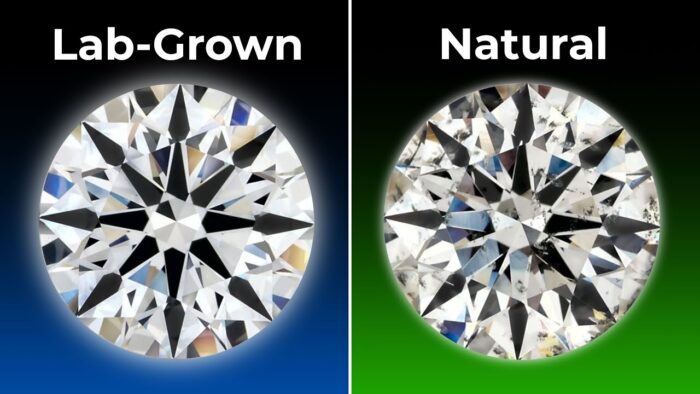
Lab-grown diamonds, also known as man-made or artificial diamonds, are gems produced in a controlled laboratory environment. They are created through two primary methods: High Pressure High Temperature (HPHT) and Chemical Vapor Deposition (CVD). HPHT replicates the natural conditions that form diamonds beneath the Earth’s crust, while CVD involves breaking down gasses into carbon atoms, which then deposit onto a diamond seed crystal.
The popularity of man-made diamonds is on the rise, driven by a combination of factors including affordability, ethical considerations, and environmental sustainability. These rocks, identical to their natural counterparts in terms of physical properties and appearance, are increasingly accepted as a viable alternative in the market. The growth of this sector is reshaping the entire industry, challenging traditional norms and opening up new possibilities.
Comparison with Natural Diamonds

Artificial diamonds and natural ones share the same physical and chemical properties, including hardness, refractive index, and dispersion. They are both composed of carbon atoms arranged in a crystal lattice structure. To the naked eye, and even under a jeweler’s loupe, they are virtually indistinguishable. There are key differences.
Natural diamonds are formed over billions of years under extreme heat and pressure deep within the Earth, making each one unique. Lab-grown kinds, on the other hand, are created in a matter of weeks, and their production can be controlled to minimize flaws and optimize quality. In terms of value, natural ones often command higher prices due to their rarity and unique origin, but this is changing as artificial diamonds gain acceptance.
Environmental Benefits
The production of lab-grown diamonds has a significantly lower environmental impact compared to mining natural rocks. It requires less water and energy, and it doesn’t result in soil degradation, deforestation, or displacement of wildlife. Man made diamonds have a smaller carbon footprint, contributing to the fight against climate change.
Sustainable practices are becoming increasingly important in the diamond industry. Consumers are more conscious of the environmental impact of their purchases, and businesses are recognizing the need to align with these values. Artificial rocks offer a solution that is both eco-friendly and appealing to consumers.
Ethical Considerations
The natural diamond industry has been marred by ethical issues, including conflict kinds, child labor, and poor working conditions. Lab-grown rocks present an ethical alternative, as their production doesn’t involve these human rights abuses.
Lab-grown types are traceable, providing consumers with assurance of their origin. This transparency is a key selling point, especially for younger consumers who prioritize ethical sourcing and corporate responsibility.
Affordability and Accessibility

Lab-grown diamonds are typically 20-30% cheaper than natural ones. This price difference makes diamond jewelry more accessible to a wider audience, including younger consumers who may have been priced out of the natural jewel market.
The affordability of artificial diamonds doesn’t compromise their quality. Consumers can purchase larger or higher quality lab-grown rocks for the same price as a smaller or lower quality natural diamond. This value proposition is driving the growth of the lab-grown jewels market.
Consumer Perception and Acceptance
Consumer attitudes towards lab-grown diamonds are evolving. While some consumers still prefer natural rocks for their unique origin and perceived value, others are embracing artificial types for their affordability, ethical production, and environmental sustainability.
Factors influencing consumer preferences include price, quality, ethical considerations, and environmental impact. As awareness and understanding of lab-grown diamonds increase, so does their acceptance.
Impact on the Traditional Diamond Industry
The rise of lab-grown diamonds is disrupting the traditional jewel industry. Some natural gem producers and retailers are embracing this change, incorporating lab-grown diamonds into their product offerings. Others are investing in marketing campaigns to differentiate natural ones and maintain their premium status.
The traditional diamond industry is also facing pressure to improve its ethical and environmental practices in response to the transparency offered by artificial jewels. This competition is driving positive change in the industry.
Innovation and Advancements in Technology

The production of lab-grown diamonds is a testament to technological innovation. The processes of HPHT and CVD are continually being refined to increase efficiency, reduce costs, and improve the quality of the rocks produced.
Research is ongoing, with scientists exploring new methods and technologies to further enhance the production of lab-grown diamonds. These advancements are not only reshaping the entire industry, but also have potential applications in other fields, such as electronics and healthcare.
Market Trends and Forecasts
The market for lab-grown diamonds is experiencing a rapid surge, driven by factors such as increasing consumer acceptance, affordability, and ethical and environmental considerations. Market research predicts that the lab-grown rocks market will continue to expand at an accelerated pace in the coming years, potentially outpacing the growth of the natural diamond market, a testament to the shifting consumer preferences.
This growth is expected to be particularly strong in the engagement and wedding ring segment, a traditionally significant sector, where consumers are increasingly choosing lab-grown jewels. They are drawn to their value, ethical production, and environmental sustainability, all of which align with modern consumer values.
Reshaping the Jewelry Industry
Lab-grown diamonds are not just a product; they are influencing jewelry design and manufacturing in profound ways. Their affordability, coupled with availability in a diverse range of colors and sizes, are inspiring designers to push boundaries and create innovative and unique pieces that were previously unimaginable.
Collaborations between avant-garde designers and lab-grown rocks producers are becoming more common, leading to exciting new collections that challenge traditional norms. These partnerships are creating jewelry that appeals to a new generation of consumers, who value both style and sustainability.
Consumer Education and Awareness

Educating consumers about the reality and benefits of lab-grown diamonds is crucial for their continued growth in the market. Industry stakeholders, recognizing this need, are investing heavily in marketing and education efforts to increase awareness and transparency, a key factor in building consumer trust.
These efforts are aimed at dispelling prevalent misconceptions about lab-grown gems and highlighting their numerous benefits. These include affordability, ethical production, and environmental sustainability, factors that resonate with the conscientious consumers of today.
Conclusion: The Future of Lab-Grown Diamonds
Lab-grown diamonds have the potential to reshape the whole industry. They offer a viable alternative to natural rocks, with benefits that align with the values of today’s consumers.
The future of lab-grown diamonds looks bright. As technology advances, consumer acceptance grows, and the industry continues to innovate, lab-grown jewels are set to play a significant role in the future of the diamond market.











